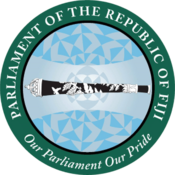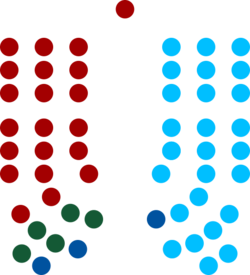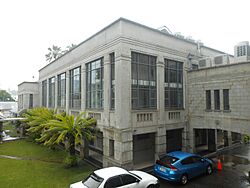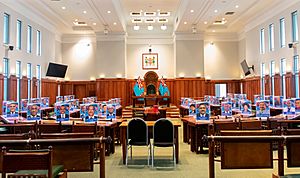Parliament of Fiji facts for kids
Quick facts for kids Parliament of the Republic of FijiPalimedi ni Matanitu Tugalala o Viti (Fijian) फिजी गणराज्य की संसद (Fiji Hindi) |
|
|---|---|
| 8th Republican Parliament | |
 |
|
| Type | |
| Type | |
| Leadership | |
|
Speaker
|
Filimoni Jitoko
Since 12 November 2024 |
|
Leader of the Opposition
|
|
|
Secretary-General
|
Jeanette Emberson
Since 17 September 2021 |
| Structure | |
| Seats | 55 members |
 |
|
|
Political groups
|
Government (29)
Opposition (26)
|
| Elections | |
| Open-list proportional representation in a single nationwide constituency using the D'Hondt method with a 5% threshold | |
|
Last election
|
14 December 2022 |
|
Next election
|
2026 |
| Meeting place | |
 |
|
| Government Buildings, Suva | |
The Parliament of the Republic of Fiji is like the main law-making body for the country of Fiji. It has one main group of lawmakers, called a single chamber. There are 55 people who work in the Parliament. They are chosen by the people of Fiji in elections every four years. These elections use a special system called proportional representation, which helps make sure different groups are fairly represented.
Contents
History of Fiji's Parliament
How Fiji's Parliament Started
The Parliament of Fiji began on October 10, 1970. This was the day Fiji became an independent country, no longer ruled by the United Kingdom. Before this, Fiji had a different law-making group called the Legislative Council. This council had been around in different forms during the time Fiji was a colony. When Fiji became independent, the old Legislative Council was renamed the House of Representatives. It stayed in charge until the first elections in 1972.
Times When Parliament Was Interrupted
Since Fiji became independent, its Parliament has stopped working normally three times.
- The first time was from 1987 to 1992. This happened because of two times when the government was taken over by force in 1987. These events were led by Lieutenant Colonel Sitiveni Rabuka.
- The second interruption happened in 2000. Another takeover attempt made it impossible for Parliament to work. So, Parliament was closed down. A new election in 2001 helped bring back the democratic system.
- The Republic of Fiji Military Forces, led by Frank Bainimarama, took over the government again in 2006. No more elections were held until September 2014.
How Parliament Members Were Chosen in the Past
The way Parliament was set up has changed over the years.
- From 1972 to 1987, there were 52 members in the House of Representatives and 22 members in the Senate.
- In 1992, Parliament grew to 70 Representatives and 34 Senators. In 1999, these numbers changed slightly to 71 Representatives and 32 Senators.
- Out of these, 25 members were chosen by all citizens. The other 46 seats were set aside for Fiji's different ethnic groups. These members were chosen from special lists for each group: 23 for Fijians, 19 for Indo-Fijians, 1 for Rotuman people, and 3 for "General electors" (like Europeans, Chinese, and other minority groups).
The Senate was the upper part of Parliament. It had 32 members. These members were officially chosen by the President. They were nominated by different groups:
- The Great Council of Chiefs nominated 14 members.
- The Prime Minister nominated 9 members.
- The Leader of the Opposition nominated 8 members.
- The Rotuman Islands Council nominated 1 member.
The Senate had less power than the House of Representatives. It could not start new laws, but it could say no to them or suggest changes. For money-related laws, the Senate could only say no to the whole law, not change parts of it. If the Senate said no to a law, the House of Representatives could pass it again later. This would make the law go through even without the Senate's approval. However, changes to the Constitution needed the Senate's full agreement.
Fiji's Single-Chamber Parliament
In 2013, a new Constitution was put in place by the government that was supported by the military. This new Constitution got rid of both the Senate and the House of Representatives. Instead, it created a single-chamber Parliament with 50 members.
The Constitution also says that the Fiji Electoral Commission must check the number of Parliament members before each general election. They can increase or decrease the total number of members if needed. They make sure the number of members is fair compared to the population. They use information from the latest census and voter lists to decide.
Because of these reviews:
- The Parliament had 50 seats in the 2014 election.
- It had 51 seats in the 2018 election.
- And it had 55 seats in the 2022 election.
How Fiji's Parliament Works Today
The Parliament of Fiji has 55 members and a Speaker. The Speaker is like the referee who makes sure meetings run smoothly. The Parliament is led by the Prime Minister. The Prime Minister is usually the leader of the biggest political party in the government.
The current Parliament was chosen in the 2022 election. A group of parties, including the People's Alliance, the National Federation Party (NFP), and the Social Democratic Liberal Party (SODELPA), formed a team. They hold 29 seats, which is more than half, so they are the government. The party called FijiFirst, led by Frank Bainimarama, has 26 seats. They are the main opposition party. The current Prime Minister is Sitiveni Rabuka.
Speakers of Parliament
The Speaker is a very important person in Parliament. They make sure that debates are fair and that rules are followed. Here are some of the people who have been Speaker:
| Image | Name | Started Role | Left Role | Notes |
|---|---|---|---|---|
 |
Jiko Luveni | October 6, 2014 | December 22, 2018 | Passed away while in office |
 |
Ratu Epeli Nailatikau | February 11, 2019 | December 24, 2022 | |
 |
Ratu Naiqama Lalabalavu | December 24, 2022 | November 12, 2024 | |
| Filimone Jitoko | November 12, 2024 | Current Speaker |
Learn More About Fiji's Government
- Politics of Fiji
- Legislative Council of Fiji (before 1970)
- House of Representatives of Fiji (from 1970 to 2006)
- Senate of Fiji (from 1970 to 2006)
- List of parliaments of Fiji (from 1970 to today)
- List of legislatures by country
See also
 In Spanish: Parlamento de Fiyi para niños
In Spanish: Parlamento de Fiyi para niños


